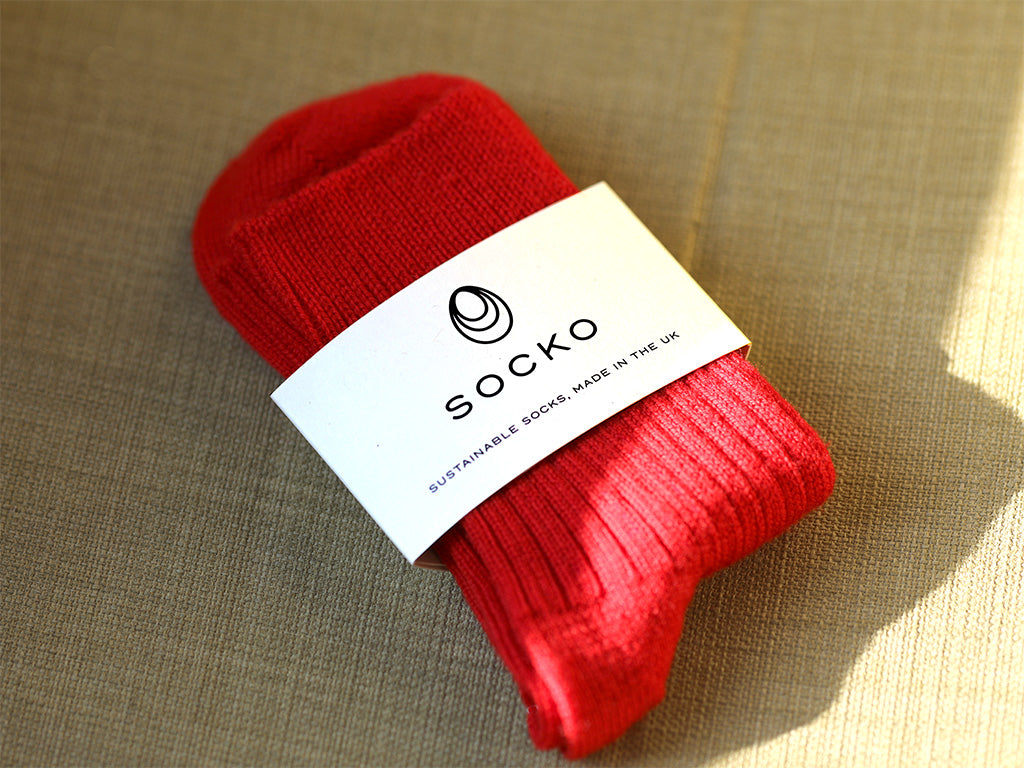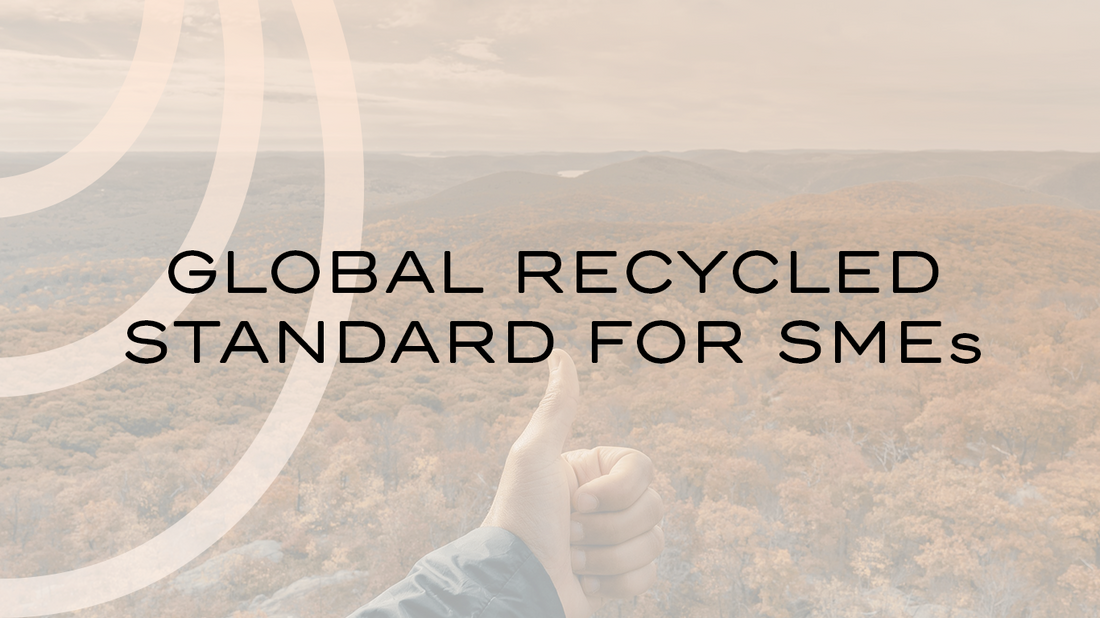5 things I wish I'd known about getting certified as a small business
Using third-party certification as a sustainable business has its merits; it’s a quick way to tell your story that cuts through the sea of greenwashing and lets customers know that the due diligence process has been done for them.

It’s also a helpful tool as a business when sourcing component materials. It gives confidence that a standard is being upheld and that you can have faith in the company that you are doing business with as well as its suppliers.
For our 100% recycled range, we were keen to be able to have a certification on our packaging but it is not as simple as going through an application process. There is no shortage of information available on the Textile Exchange website, however, it is near impossible to have a one size fits all answer to many questions, especially as a micro business. Despite not being one to shy away from the subsections of a lengthy PDF, the time it took to go through and still have questions at the end of it led me to write this post.
These are some of the things I wish I had been clear on from the get go:
The audit
The very first thing to consider before entering into the application process is whether you have the financial means to get certified in the first place. This can be difficult to know as not all certification bodies offer a clear pricing list like this one from B-Corp. In the case of Textile Exchange, it is not assessed by your company’s turnover but instead by the time it will take them to carry out the audit. i.e. whether you’re a global conglomerate or a one person company, the day rate is fixed. This lack of means testing naturally makes getting the certification a question of scale - the audit is a drop in the ocean for a large business, even if they have multiple large premises, whereas from Socko’s business perspective, the cost is more than we spend on advertising in a year.
Please also note that the audit needs to be conducted annually, it’s not a once and done exercise. The certificate is only valid for 12 months so this would be an annual charge and an annual ask of your manufacturers so you should consider not only your costs but their time.

I have a great relationship with my manufacturers. The ease with which I can hop on a train and visit the factory is what I love about making in the UK. I know the factory and those who work there well. When I spoke to them about the possibility of carrying out an audit there was concern based on their previous experience. For example, some of the questions they had encountered through another audit included “Do you have anyone sleeping in the premises overnight?”. As a small family-run business, to be approached with a lengthy box ticking exercise that doesn’t treat businesses as people is not only irksome but can be insulting.
You will not know if you are compliant with the requirements necessary to become certified until you have undergone the audit. According to Control Union, the body who carries out the certification process on behalf of Textile Exchange, “All the requirements are clearly listed in the standard document [36 pages] and the user manual [60 pages].”

© Textile Exchange
Global Recycled Standard materials
At Socko, I’ve gone to great lengths to source GRS certified materials from GRS certified companies. Some of the relationships have taken a year or more to set up. With new product development, like the elastic used in the cuffs of our socks, it’s difficult to know what the lead times will be from placing an order through to receiving the fibre and turning it into socks. Minimum order quantities also mean that you are sitting on large (for a small business) quantities of material before you have all the ingredients to finally get going.
The audit can still take place even if the GRS certified materials are not yet with your manufacturer. In fact, I would recommend that they are not (subject to any sampling you have been able to do) because each order of each material will require what’s known as a transaction certificate (more on those later) as well as a “Scope certificate”.
The chicken and egg dilemma is this: Material that is not yet socks does not make money so it would not have been possible to pay for the audit prior to sourcing the materials. However even certified materials, sourced prior to your business being certified, cannot be deemed certified. This means that I need to use up all of the material that I have (make and sell approximately 10,000 pairs of socks) before applying to be certified and then ordering new materials, which can take anywhere up to a year to arrive and be turned into socks. To me that’s the financial sand slipping through the annual fee hourglass.
 The most comprehensive flow chart we've found of the certification process. The same for GRS as it is for GOTS.
The most comprehensive flow chart we've found of the certification process. The same for GRS as it is for GOTS.
The portal
Early on in the process, you are given your company’s log in to an online portal. Before I sound too critical, please bear in mind that this is my first foray into certification; if this is your bread and butter and you have experience of GRS or other standards, this may all make perfect sense. From an outsider’s perspective, the portal is not user friendly. Any UX designers looking for a challenge, I recommend contacting Control Union.
Want to register a product? Don’t expect to be able to rely on intuition or for a linear process.
The training videos available make a lot of assumptions and any specific questions to your business require an email. For example, would you classify unisex socks as unisex apparel, worn accessories, functional accessories, footwear or Other? As far as I could tell, there is no right answer [though there’s bound to be a wrong one…] as ‘Socks, hosiery (PD0009)’ falls under all of the above.
When you’re one person and already the chief financial officer one minute and the head of sales the next, this is yet another thing to have to learn.
TCs - Transaction certificates
An acronym worth being aware of and the glue behind this beast of a system. The certificates themselves look a little something like this. It costs £40 per transaction certificate.
And, as mentioned, is only applicable to materials bought once you are certified, although companies can issue TCs for items purchased up to 180 days previously. Certificates are passed from suppliers and subcontractors to ensure that by the time the product reaches you it is still certified. However, further confusion came about with my suppliers/subcontractors as the company wrapping the nylon that I own around the elastomeric is supplying the elastomeric but also wrapping it. Are they a supplier or a subcontractor? They cannot be both. The dyers also sent me the following message
“Also note that this is a recycled yarn, nevertheless, seeing that this is a provision of services we will not be able to pass the Transaction Certificate, as this yarn is not in the stock of the Certification Entity Portal. For this, we had to buy the yarn, your supplier had to pass us the Transaction Certificate so we could afterwards also pass the Transaction Certificate.” Again, this may seem very straightforward to some of you but it had me reaching for the paracetamol.
Logo use
In the introduction to this post I stated that my main reason for wanting to become GRS certified was in order to use the logo on our packaging, to certify that the content is truly 100% recycled and as a point of differentiation from the other partially recycled socks entering the market. However, in order for this to be of value to Socko customers, I wanted to see how many of them knew what the logo stands for

|
 |
 |
Even with the words, only 33% of people recognised the logo and only two people could hazard guesses as to what it means.
“It means the fabric used is made from actual recycled materials.”
“Ummm the yarn in your socks is recycled? Pre consumer waste maybe?”
Logos can also be misconstrued; Terracycle has come under flack recently, accused of “deceptive” recycling claims.
Getting the 100% recycled message therefore seems to be more effective when told in a very visceral manner, as with Patagonia’s latest Puffy Jacket campaign

Our iconic Down Sweater is now warmer, softer, more durable and made with 100% recycled fishing nets.
Thankfully, storytelling is something even us microbusinesses can do. This is why, for now at least, we will be sticking to transparency and to telling our story until we can justify the cost and quantify the value of certification.



: invalid url input -->)